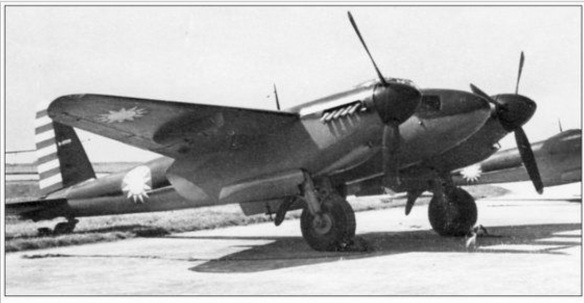A Canadian-built FB.Mk. 26, believed to be ‘B-M008’. The Nationalist Chinese purchased nearly 180 FB.Mk. 26s and T.Mk.29s from surplus Canadian stocks in 1947.
The Nationalist Government of China had shown considerable interest in the later stages of Mosquito production in Canada, and inspecting Chinese Air Force officers were seen regularly at the Toronto plant. With the end of the war, many surplus Mosquitos were stored at Downsview. In late 1947 the Canadian Government, represented by Roy Peers, and Lieutenant-Colonel R. P. Mow on behalf of the Chinese, concluded negotiations for the sale to the Chinese Nationalist Government of around 180 aircraft at knock-down prices, which cleared out almost the entire stock of Mosquitos held in reserve by the RCAF. Due to the politics of the time, the Canadian Government went to great lengths to emphasize that this was a purely commercial arrangement and did not imply aid for Chiang Kai-Shek against the Communists. De Havilland Canada provided planning and technical support, much of which came from Fred Plumb who, since the days of working in Salisbury Hall on the prototypes, had moved from England to become DH Canada’s Works Manager. The Mosquitos were dismantled at Downsview during October 1947 and packed into crates that had previously been used to ship Vampires out from Hatfield to Canada before being transported by rail to a Canadian port and then by sea to Shanghai. From there they were transferred to Tazang Air Base for reassembly and were then test- flown under the direction of De Havilland personnel before being handed over to the Chinese.
First to arrive were several T. Mk.27 trainers, followed by considerable numbers of FB.26s and some T.29s. A fair number of aircraft sub- assemblies failed to survive the winter crossing of the Atlantic, through the Suez Canal and on to Shanghai, suffering severe salt corrosion and damage to electrical and metal parts. So bad was the damage that some aircraft could only be cannibalized for spares, and the remainder of the airframes scrapped.
Training accidents were common when the aircraft were flown by Chinese Air Force instructors and students, and many Mosquitos were written off. In an attempt to reduce these accidents, a fighter-bomber (KA252) was modified into a taxi-trainer, with the undercarriage locked down and bracing tubes bolted between each undercarriage leg, the fuselage and the outer wings. Although this machine could not be flown, the Chinese still managed to write this aircraft off when it was taxied into a hole.
It was in China that the Mosquito gained yet another nickname, ‘Lin Tai Yu’ after a legendary Empress who was ‘beautiful but wicked’. The Chinese attempted to use the aircraft against the Communists, with possibly four lost in combat, but in the end they were defeated by the Communist’s guerrilla tactics. The situation within the country had deteriorated, and by late 1948 the Canadians were advised to leave. Finally the Communists overran the country and the remaining airworthy Mosquitos were evacuated to Formosa by escaping Nationalist pilots. There they were used for a short while against shipping, but nothing further is known of their fate.
George E. Stewart DFC
George E. Stewart, a Canadian, flew 50 Ops on the Mosquito with No. 23 Squadron between July-November 1944 – all by the time he was 21. He was awarded the Distinguished Flying Cross for this work, which was mostly day/night intruder operations.
After the war George spent time in China training Chinese Nationalist Air Force pilots on the aircraft in an effort to reduce their frightening loss of pilots to accidents. Both his unsurpassable knowledge of flying the Mosquito and his unquenchable enthusiasm for it will be of the utmost value to The People’s Mosquito as we move forward. Already over the three years he has given invaluable advice to both the Kiwi and US pilots who have flown the recently restored FB.26 KA114, which they have all used to good effect.
